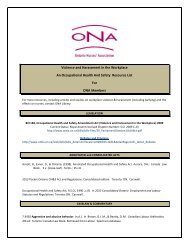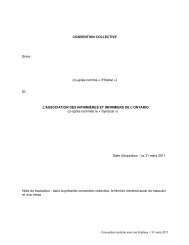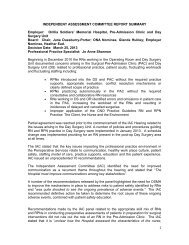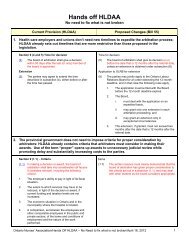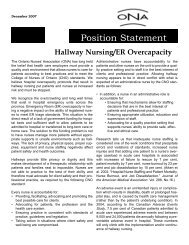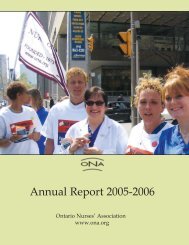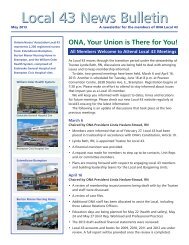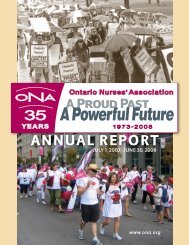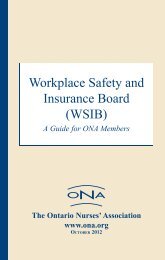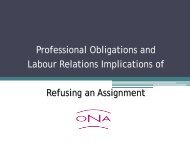Patient Care Needs Assessment Tool - Sunnybrook Health Sciences ...
Patient Care Needs Assessment Tool - Sunnybrook Health Sciences ...
Patient Care Needs Assessment Tool - Sunnybrook Health Sciences ...
You also want an ePaper? Increase the reach of your titles
YUMPU automatically turns print PDFs into web optimized ePapers that Google loves.
AcknowledgementsThe Project Steering Committee would like to thank the Nursing Secretariat of the Ontario Ministryof <strong>Health</strong> and Long-Term <strong>Care</strong> for their generous funding of this project. Our gratitude is extended tothe nurses who completed the clinical reviews and those who completed a questionnaire or participatedin the focus group interviews. In addition, our sincere appreciation is extended to the healthcare organizations that supported the reviews, focus group interviews, and questionnaire completion.We would also like to convey our humble gratitude for contributions by Alex Kiss, Patricia Lyon,Ross Riggs, and Salin Kim. Finally, we would like to acknowledge the work of the College of Nursesof Ontario and Linda Lee O’Brien-Pallas.
TABLE OF CONTENTSHHR Demonstration Project[April 30, 2009]1 Introduction ....................................................................................................62 Development of the <strong>Tool</strong>kit.............................................................................73 Description of <strong>Tool</strong>s and Process...................................................................83.1 <strong>Patient</strong> <strong>Care</strong> <strong>Needs</strong> <strong>Assessment</strong> <strong>Tool</strong>.....................................................83.2 <strong>Patient</strong> <strong>Care</strong> <strong>Needs</strong> <strong>Assessment</strong> Review Process ..................................83.3 Unit Environment Profile <strong>Tool</strong> ................................................................113.4 Staff Mix Decision Making......................................................................114 Critical Success Factors and Lessons Learned ...........................................125 References...................................................................................................146 Appendix A - <strong>Patient</strong> <strong>Care</strong> <strong>Needs</strong> <strong>Assessment</strong> <strong>Tool</strong>....................................157 Appendix B - Guidelines for Nursing Leaders ..............................................178 Appendix C - Introductory Script for Unit Review Process ...........................189 Appendix D - Definitions of Stability, Complexity, & Predictability................1910 Appendix E - Unit Environment Profile <strong>Tool</strong> .................................................20RN/RPN Utilization <strong>Tool</strong>kitv ]
1. IntroductionHHR Demonstration Project[April 30, 2009]Nurse staffing is critical to patient safety, health and well being, as nurses deliver moreindividual health care than any other healthcare provider (CHSRF, 2006). Appropriatestaffing is not dependent merely upon the number of nurses providing care on aclinical ward, but involves having nurses with the right skills, experience, education,working within the right type of staffing model and the right mix of other healthcareproviders (CHSRF, 2006).Across Canada, provincial governments are facing record deficits and health carefunding reductions. Nursing resources are frequently scrutinized for potential costsavings in times of budget constraints. As a result, pressure is placed on nursingadministration and managers to consider various staff mix changes, includingalternations in RN/RPN ratios as well as the addition of unregulated workers.Nursing leaders require evidence-based tools and processes in order to formulate andjustify staff mix decisions that meet patient care needs and are fiscally responsible.The College of Nurses of Ontario’s (2008) three-factor framework on the Utilization ofRNs and RPNs emphasizes the integration of patient, environment, and nurse factorsin determining the appropriate category of nurse caregiver.This toolkit is designed to assist decision makers with the complex task of matchingpatient care needs, nursing human resources, and the environment. It is comprised oftwo key tools, the <strong>Patient</strong> <strong>Care</strong> <strong>Needs</strong> <strong>Assessment</strong> (PCNA) and Unit EnvironmentalProfile (UEP). These tools are intended to be used in conjunction with the specificconsensus-based review process as described in this document. Application of thetools and process will assist nursing leaders who are contemplating staff mix changesas well as those who are re-evaluating their current staff mix, for example when thereare changes in the patient population or environmental context.The consensus-based review process includes the staff nurses caring for the patientsin the clinical unit as well as key unit nursing leaders. Involvement of both front-linestaff and nurse leaders in determining patient care needs facilitates a comprehensiveand shared understanding of the range of needs, how they relate to RN/RPN utilizationand enhances the acceptance of potential changes in skill mix.Utilization of this toolkit requires a clear understanding of the factors that impact skillmix decisions and how they inter-relate. For example, knowledge of current scope ofpractice for both RNs and RPNs; awareness of what is currently happening in thehealth care environment; labour relations considerations; workforce demographics;attrition; and regulatory changes can all impact the appropriateness of skill mixchanges. Ultimately, it is essential that leaders have knowledge and ability to measureand monitor trends in patient, nurse, team, and system outcomes in order to evaluateand defend their decisions.RN/RPN Utilization <strong>Tool</strong>kit6 ]
HHR Demonstration Project[April 30, 2009]2. Development of the <strong>Tool</strong>kitIn 2007, the Ontario Ministry of <strong>Health</strong> and Long-Term <strong>Care</strong> identified the need forlong range health human resource (HHR) planning. In response, the NursingSecretariat funded 17 Demonstration Projects. The “RN/RPN Utilization <strong>Tool</strong>-KitProject” was one of the projects selected for funding. The partnership of hospitals forthis project included the lead, <strong>Sunnybrook</strong> <strong>Health</strong> <strong>Sciences</strong> Centre (SHSC), andUniversity <strong>Health</strong> Network, St. Michael’s Hospital, Hamilton <strong>Health</strong> <strong>Sciences</strong>, NorthYork General Hospital, Scarborough General Hospital and Kingston General Hospital.The mix of academic and community hospitals in southern Ontario offered a broadscope for the project focusing on medical-surgical units.The purpose of the demonstration project was to produce a toolkit based on the PCNAand UEP to support nursing staff mix decision-making for medical-surgical inpatientunits in both large and small hospitals. To achieve this, the project involved thesystematic assessment of the reliability and validity of the PCNA, the validity of theUEP, and the procedure for conducting a unit review. The project also included adescription of the processes through which nursing leaders would utilize the data fromthe unit reviews in making nursing staff mix decisions.A descriptive exploratory design using a combination of quantitative and qualitativeapproaches, and a convenience sample of 36 medical/surgical units across sevenacute care hospitals was used. Reviews of patient care needs were conducted oneach participating unit on two separate occasions, using a consensus-basedapproach. Information about unit characteristics was collected by survey following thepatient reviews on each unit. Debriefing meetings were held with unit leaders to reviewpatient and unit data and explore ways in which these data could be used to supportnursing staff mix decision-making. Focus groups with review participants wereconducted following the reviews to assess participants’ responses and perceptions ofthe review process.The research supported the validity and reliability of the <strong>Patient</strong> <strong>Care</strong> <strong>Needs</strong><strong>Assessment</strong> tool and the consensus based process for conducting patient carereviews. While the analysis of the data evaluating the Unit Environmental Profile toolprovided limited evidence of the tool’s face validity and feasibility, it did indicate thatthe respondents were reasonably satisfied that the UEP tool was capturing some ofthe elements of interest to determine environmental complexity. The results alsoshowed that managers had some understanding about how to use the PCNA data butwere less clear about how to integrate UEP information into nursing staff mixdecisions.RN/RPN Utilization <strong>Tool</strong>kit7 ]
HHR Demonstration Project[April 30, 2009]3. Description of <strong>Tool</strong>s and ProcessThe RN/RPN Utilization toolkit has four components. It is designed to assist decisionmakers with the complex task of matching patient care needs, nursing humanresources, and the environment in acute care medical/surgical units.3.1. <strong>Patient</strong> <strong>Care</strong> <strong>Needs</strong> <strong>Assessment</strong> <strong>Tool</strong>The <strong>Patient</strong> <strong>Care</strong> <strong>Needs</strong> <strong>Assessment</strong> (PCNA) tool (see Appendix A) is used to providea composite picture of the nursing care needs of patients on an inpatient unit. The toolassesses each patient’s needs for nursing care based on the stability, complexity, andpredictability of the patient’s condition and their level of risk for negative outcomes.The PCNA is structured so that responses to questions about specific elements of thepatient’s situation and plan of care build to an assessment of their levels on each ofthese four dimensions.Evaluation of the PCNA has shown that it is effective in discriminating among patientswith respect to these four dimensions. The College of Nurses of Ontario’s three-factorframework (2008) suggests that RPNs are prepared to care autonomously for lesscomplex, more stable and predictable patients who have less risk for negativeoutcomes, while the greater depth and breadth of the knowledge base of RNs isrequired to manage the care of more complex, less predictable, higher risk patients.The PCNA is completed by a panel of nurse reviewers for each patient on the unitusing a consensus-based review process. The panel consists of the patient’s assignednurse, the manager and/or team leader, and the advanced practice nurse, clinicalnurse specialist, or clinical educator associated with the unit. A nurse facilitator who isnot part of the unit clinical team leads the review panel. The review panel may alsowish to assign a designated scribe to document responses to the PCNA questions.3.2. <strong>Patient</strong> <strong>Care</strong> <strong>Needs</strong> <strong>Assessment</strong> Review ProcessThe characteristics of the review process are based on the belief that throughrespectful engagement between front line nurses and nursing leaders on the unit theneeds of patients can be articulated and agreed upon using the tool. The need forguided facilitation through each question is paramount in order to achievecollaboration and to reach consensus on the responses and ratings.In the review the tool is applied systematically to each of the patients on the unit. Thisinvolves the facilitator reading each item aloud and inviting input and discussion fromthe review team members regarding an appropriate response to the item. Throughdiscussion, the group comes to consensus on the scoring for each item on the tool.The consensus response to each item is documented on the PCNA tool by thefacilitator, or by an assigned scribe.RN/RPN Utilization <strong>Tool</strong>kit8 ]
HHR Demonstration Project[April 30, 2009]A typical review for a unit of 30 medical-surgical inpatients requires six to seven and ahalf hours.The clinical review team is comprised of 2 – 3 “external” participants and 2 – 3“internal” participants. External participants include nurse leaders external to theclinical unit. Internal participants include the nurse caring for the patient that is beingreviewed and nurse leaders such as the manager, clinical educator, and/or chargenurse.It is strongly recommended that the external review team members remain consistentwithin an organization. Expertise in conducting and facilitating the reviews developswith experience. The knowledge gained about the subtle differences in patientpopulations and the impact this may have on staffing decisions is invaluable.Advance preparation of staff and leaders is advised prior to the clinical review.Preparation includes communication about the roles of RNs and RPNs, the purpose ofthe clinical review, the tools, and the process. Advance communication and discussionwith the unit staff is intended to clarify the project goals and objectives, provide anopportunity to address myths and misbeliefs about staff mix, and to review currentinformation regarding RN/RPN scope of practice. Presentations at nursing councils,nursing newsletters, unit staff meetings, one-on-one discussions with staff, and e-mailnotices may be utilized to prepare the front line staff for the reviews. Repeatedcommunication may be necessary.Providing information to the leaders as well as the front line staff is a key strategy forsuccess. Preparatory information should include:• Overview of the RPN diploma program curriculum• College of Nurses of Ontario 3-factor framework for utilization of RNsand RPNs (College of Nurses of Ontario, 2008)• Written articles, discussion at nursing council, meetings with the nursingleaders, meetings with staff nurses, and distribution of the toolsClinical review leaders are advised to prepare for the role of facilitator throughcoaching, role modeling and sharing tips to maximize their ability to conduct thereviews according to the principles for achieving respectful engagement. Externalreview team members should have a clear understanding of consensus-baseddecision-making.Practical aspects of the preparation for each review include advanced booking for anadditional nurse. The role of this nurse is to provide coverage for each of the nurseson the unit as they take turns participating in reviewing their assigned patients. A roomshould be booked for the review, catering arranged if required, and photocopies of thetools should be obtained (PCNA tool for each patient and each reviewer, list ofdefinitions, and a copy of the UEP tool for the clinical manager).RN/RPN Utilization <strong>Tool</strong>kit9 ]
HHR Demonstration Project[April 30, 2009]It is important to have one person responsible for coordinating the review process onthe day of the review. This can be the facilitator or another individual who is not part ofthe unit clinical team. The steps for conducting the review are as follows:I. Ensure that all review panelists are available.II. Establish the order in which the nurses on the unit will participate in the review.Identify the process that will be used for each nurse to hand over theirassignment and how each nurse will be informed of their turn to participate.III. Arrange for the review panel members to have access to the patient’s healthrecord including the chart, medication profiles, kardexes, flowsheets, and shiftreport notes during the review.IV. Identify which member of the internal review team will review the chart whenneeded, and which member will review the kardex.V. Decide in advance the plan for seating, order of staff nurse participation, andbreaks. It is helpful for the facilitator to sit across from the staff nurse as thisenables direct eye contact and engagement of the staff nurse.VI. Review the Guidelines for Leaders (see Appendix B) prior to inviting the staffnurse to join the review team.VII. Using the introductory script as a guideline (see Appendix C), provide anoverview of the project for each new nurse as she/he joins the review and explainthe role of each member at the table including the scribe, if presentVIII. Provide a copy of the PCNA tool and definitions to everyone. Review thedefinitions for stability, complexity, and predictability (see Appendix D) with theteam members as needed to facilitate scoring.IX. Conduct each patient review by posing the questions in order to the internalreview team members as a group (patient’s nurse, unit nurse leaders). Providetime for response by the nurse and the internal review team members then checkwith everyone else at the table to see if they agree or if there is anything else toadd. Do not skip questions or make assumptions. If there is disagreement amongpanel members regarding the appropriate response to an item, seek clarity orelicit additional detail by asking questions, summarizing or reading back theresponses from other questions.X. Document each response on the PCNA tool.XI. As the review team completes the review on each patient group the patients intothree categories based on the client continuum [Less complex, predictable, lowrisk for negative outcome(s) >>>>> highly complex, unpredictable, high risk fornegative outcome(s)]. (College of Nurses Practice Guideline for Utilization of RNsand RPNs, May 2008).RN/RPN Utilization <strong>Tool</strong>kit10 ]
HHR Demonstration Project[April 30, 2009]3.3. Unit Environment Profile <strong>Tool</strong>The Unit Environment Profile (UEP) tool (see Appendix E) was designed to informdecision-makers of the complexities and dynamics of their clinical practice setting.Complementing the results of the <strong>Patient</strong> <strong>Care</strong> <strong>Needs</strong> <strong>Assessment</strong> (PCNA) reviews,the UEP tool is based on the understanding of the necessity to appreciate the contextin which nurses practise and by so doing better inform the decisions regarding staffmix.Supported by evidence from the literature (O’Brien-Pallas, Irvine, Peereboom, &Murray, 1997; College of Nurses of Ontario, 2008) the tool includes 41 itemsaddressing personnel characteristics and unit characteristics.3.4. Staff-Mix Decision MakingNurse staffing, specifically the number of RNs in the staffing mix, as well as theexperience level and knowledge/skills of nurses impact the effectiveness ofsurveillance, interpretation of cues and action required to rescue the patient fromnegative consequences (Clarke & Aiken, 2003). The optimal nurse staffing modelensures that there is enough RN staffing to provide effective surveillance. In additionthe nurses caring for the patients should have the education level, knowledge andskills working with a specific patient population to interpret cues, and take appropriateimmediate actions. Access to personnel who can assist in the appropriate interventionis also important to ensuring patient safety.When making decisions regarding staffing and skill mix it is important to considermultiple factors. They include:• <strong>Patient</strong>/family <strong>Care</strong> <strong>Needs</strong>• Complexity of the Environment• Nursing complement currently in place and any predicted changeso Years of experienceo Knowledge and expertiseo Ratio of novice to experienced staff• Current context within your organizationSummarize the data from the <strong>Patient</strong> <strong>Care</strong> <strong>Needs</strong> <strong>Assessment</strong> and bring theinformation together with data from the Unit Environment Profile which includesinformation about the make up of Nurses on the unit.Assemble the leaders that support the unit to review the information. It is helpful toinclude leaders who are involved in the practice and operations of the unit, includingthose who participated in the review and those who did not. After reviewing all thedata determine if the leaders feel comfortable that the data reflects the patientpopulation and the unit.RN/RPN Utilization <strong>Tool</strong>kit11 ]
HHR Demonstration Project[April 30, 2009]If the leaders are comfortable with the data, the group may identify a number ofpossible changes to the staff mix and model of care that could be made. It is helpful tomap out different models based on the PCNA data, environmental complexity data,and the nurse data to inform the discussion. Compare and contrast both risks andbenefits to each model from a number of perspectives.Elements to consider include:• Workload• Scheduling implications (including replacement plans)• Continuity of care• Costs associated with changeo potential labor relations costso professional development (educational materials for skill development,RN/RPN team building, and inter-professional collaboration)Assess the leadership required to support the new model and establish the resources.4. Critical Success Factors and Lessons LearnedOnce the team identifies the final model to implement it is important to identify the keyoutcome measures that will be used to monitor the impact of changes and evaluatethe model. Evaluation measures should be robust and include nurse, patient andsystem outcomes.Possible metrics could include:• Pressure ulcer incidence rates• Falls-related injury rates• <strong>Patient</strong> satisfaction scores• Hospital-acquired infection rates• Nurse and team satisfaction• Staff turnover rates• <strong>Patient</strong> length of stayDedicating time to review what nurses do and know about the patients and familiesthrough the consensus based review process builds capacity through sharedunderstanding of the nursing knowledge and skill, critical thinking and care planningthat is involved in caring for the patients and families on that unit. Although staff nursesmay be apprehensive about speaking in front of their manager and other nursingleaders before going through the review the benefit of engaging front line staff isemphasized as a critical success factor for adoption and successful implementation ofchange.One aspect of nursing work that is not captured through the toolkit is the amount oftime and physical demands associated with meeting the needs of patients. Traditionalworkload measurement processes are designed to assess the volume of work thatpatients’ needs generate, and to estimate the time required to meet those needs. InRN/RPN Utilization <strong>Tool</strong>kit12 ]
HHR Demonstration Project[April 30, 2009]applying the results of the toolkit to staff mix decision-making, it is important that thisaspect of nursing work be integrated into the decision.Additional uses of the tools and processes may also be identified in the future.Therefore the PCNA might be adapted for, or integrated with procedures for guidingthe daily assignment of nurses to patients. Since the CNO framework alsoemphasizes the knowledge, skill, and experience level of the individual nurse as wellas the registration category, these factors would also need to be considered inmatching individual nurses with patients. Similarly, the toolkit could be used to assist indetermining appropriate staffing ratios; that is, the number and mix of patientsassigned to each nurse, and the total nursing staff complement required on a unit.Further use of the toolkit includes determining the supports that are required foroptimal nursing practice and patient outcomes. For example, the toolkit could beapplied as part of a comprehensive learning needs assessment for nursing staff.Because it facilitates the collection of data about the needs of the population ofpatients on a unit as well as the environmental supports available to the nursing staff,results could be used to inform development of educational programs that wouldmatch the requisite knowledge and skills to meet the needs of unique patientpopulations. Understanding the needs of patients, characteristics of nurses along withthe supports and demands of the environment could also help to identify otherenhancements such as the number and focus of nursing leadership roles or theaddition of unregulated personnel.The project team developed and tested components of the toolkit based on theCollege of Nurses of Ontario three-factor framework for utilization of RNs and RPNs.Results support the utility of the tools and procedures in informing nursing staff mixdecision-making. Future research is required to evaluate the quality of decisionsresulting from application of the toolkit, and to illuminate the processes through whichnursing leaders can best translate the information generated through the tools intostaff mix decisions.RN/RPN Utilization <strong>Tool</strong>kit13 ]
HHR Demonstration Project[April 30, 2009]5. ReferencesAiken, L. H., Clarke, S. P., & Sloane, D. M. (2002). Hospital nurse staffing and patientmortality, nurse burnout, and job dissatisfaction. Journal of the American NursesAssociation, 288 (16), 1987-1993.Canadian <strong>Health</strong> Services Research Foundation [CHSRF] (2006). Staffing for safety:A synthesis of the evidence on nurse staffing and patient safety. Ottawa, ON:Author.College of Nurses of Ontario (2008). Practice Guideline: Utilization of RNs and RPNs. Toronto,ON: Author.O’Brien-Pallas, L., Irvine, D., Peereboom, E., & Murray, M. (1997). Measuringnursing workload: Understanding the variability. Nursing Economics, 15(4),171-182.RN/RPN Utilization <strong>Tool</strong>kit14 ]
HHR Demonstration Project[April 30, 2009]5. Has the patient been experiencing acute confusion/agitation Yes No Comments:requiring ongoing assessment and treatment?6. Does the patient’s condition require increased assessment and Yes No Comments:adjustment in the plan of care? (For example, due to pain,fluctuating lab results, persistent fever, loss & grief, fluctuatingmood, blood glucose is not well controlled)7. Does the patient require interventions/treatments that will have an Yes No Comments:immediate systemic effect, which may create an urgent oremergent situation? (For example, new IV treatment, Heparininfusion therapy, chemo therapy, high alert drug treatment, firsttimeblood transfusion)8. In the last 48 hours, has the patient had an unexpected health Yes No Comments:event or crisis? (For example, severe or acute episode requiringimmediate intervention such as a sudden drop in blood pressure,O2 saturation level, blood glucose, fall)9. Do the patient and/or family have complex support needs? Yes No Comments:10. Are the patient and/or family facing complex decisions that require Yes No Comments:coordination/collaboration with multiple team members?11. Overall, how stable is this patient? Very Stable Very Unstable1 2 3 4 5 612. Overall, how complex is this patient? Less Complex Highly Complex1 2 3 4 5 613. Overall, how predictable is this patient? Highly Predictable Less Predictable1 2 3 4 5 614. Overall, how at risk is this patient for negative outcomes? Less Risk High Risk1 2 3 4 5 61Critical <strong>Care</strong> Secretariat, Ontario Ministry of <strong>Health</strong> and Long-Term <strong>Care</strong> [MOHLTC]. (2007). Ontario’s critical care strategy: Implementation of critical care response teams(CCRTs) in Ontario hospitals – Year one. Retrieved April 7, 2008 from http://www.health.gov.on.ca/english/providers/program/critical_care/docs/ccs_ccrt_rp_01_20070101.pdf***The PCNA tool is intended to be used in conjunction with the specific consensus-based review process as described inthe RN/RPN Utilization <strong>Tool</strong>kit.16 ]RN/RPN Utilization <strong>Tool</strong>kit
HHR Demonstration Project[April 30, 2009]7. Appendix B - Guidelines for Nursing LeadersBased on the pilots we have compiled the following suggestions to guide you inworking with the unit staff. Prior to the data collection please review the followingguidelines and discuss relevant aspects with the nursing leaders from each unitin order to facilitate a comfortable environment for the staff nurses and minimizeany feelings of discomfort.! Arrange seating to minimize segregation of the staff nurse – helpful if theleaders sit on either side! Pose questions to the unit staff as a group! The staff nurse may find it helpful to have the chart! Put away distractions such as blackberries and minimize the use ofpagers! Do not engage in side conversations or note writing in front of unit staff! Provide a copy of the definitions and the PCNA tool for unit staff to refer to! Throughout the review reinforce the consensus approach. Allow time fordiscussion and encourage input from all participants! Include all staff working that day – agency and relief staff may requiremore input from the nursing leaders! Where possible include the team leader/charge nurse who will know aboutpatient/family history/issuesRN/RPN Utilization <strong>Tool</strong>kit17 ]
HHR Demonstration Project[April 30, 2009]8. Appendix C – Introductory Script for Unit ReviewProcessWelcome staff nurse and thank them for their participation. Introduce everyone atthe table.Briefly go over the background and purpose of the study. Reinforce that thepurpose of the data collection on the review day is to test the tool.Outline the process of reviewing each patient using the PCNA tool! Go over the consensus approach! Define the role of all the members of the unit team at the table! Explain that the unit review will be repeated in a week or soReinforce the importance of patient confidentiality and that the externalresearchers should not know the name of the patient.Confirm that the staff nurse understands the study and ask if she/he has anyquestions.Before starting with the first patient tell the nurse that one researcher will recordthe answers. Offer to read out each question for the first patient.Check if the nurse has any questions after finishing the first patient. Beforecarrying on give them the option to either follow the tool themselves or continuereading out each element.After completing the review thank the nurse. Advise each staff member toapproach any one of the leaders at the table if they have any questions,concerns or suggestions about the tool or the process and to alert the unit leaderif there are any rumors or concerns they feel should be addressed.RN/RPN Utilization <strong>Tool</strong>kit18 ]
HHR Demonstration Project[April 30, 2009]9. Appendix D - Definitions of Stability, Complexity, &PredictabilityStability refers to how quickly and howmuch or how little the patient’scondition/care needs are changing.Complexity is concerned with theamount and diversity of factors that areaffecting the patient’s condition.Predictability refers to how well we cananticipate what is going to happen withthe patient.Stability is high when patient changesare minimal and occur over a longerperiod of time. Stability decreaseswhen changes are substantial and/orare occurring rapidly.Complexity of care increases whenpatients’ care needs are fluctuating orare not well-established, when multiplehealth problems are present, or wheninterventions may affect multiplesystems or conditions.Predictability is high when patient careneeds and responses are expected,and plans for care can be developed inadvance. Predictability decreaseswhen patient care needs are unknown,and a plan of care cannot bedetermined in advance.Definitions drawn from:College of Nurses of Ontario. (2008). Practice Guideline for the Utilization ofRNs and RPNs. Toronto, ON: Author.RN/RPN Utilization <strong>Tool</strong>kit19 ]
HHR Demonstration Project[April 30, 2009]10. Appendix E - Unit Environment Profile <strong>Tool</strong>VARIABLE DESCRIPTION DATANursing StaffHow many RNs (total FTE's) work on this unit?How many RPNs (total FTE's) work on this unit?Number of Full-Time/Part-Time/Casual Nursing Staff (totalnumber of individuals, not FTE's)Budgeted Skill MixExperience of Staff NursesEducational Preparation ofNursesCharacteristics of UnitNumber of Unregulated <strong>Patient</strong> <strong>Care</strong> Providers (totalFTE's)Number of Staff Nurses registered with College of NursesOntario for less than 3 yearsNumber of RNs with less than 1 year experience workingon the unitNumber of RPNs with less than 1 year experience workingon the unitNumber of unit Staff Nurses 55 and overNumber of Certificate RPNsNumber of Diploma RNs/RPNsNumber of Degree RNsNumber of Masters Prepared RNsNumber of Nurses with Specialty Certificates (e.g. CNAcertification, gerontology certificate, critical care certificate,etc)Average Length of stayRN/RPN Utilization <strong>Tool</strong>kit20 ]
HHR Demonstration Project[April 30, 2009]Description of Support onUnitOccupancyNurse-patient ratioPolicies, Procedures, andGuidelinesUnanticipated eventsManager Yes NoOther unit-based nursing leader support (e.g. Educator,APN) Yes NoOther nursing leader support on consultative basis Yes NoAccess to Rapid Response Team Yes NoAccess to other allied health support (Specify roles)In-charge/Team leader without assignment (day shift) Yes NoNumber of medical teams on the unitAny clinical Associates, or Physician assistant role? Yes NoDo you have nursing students on the unit? If so, whattimes of the year and what year of nursing?Other nursing roles on the unitAverage occupancy year to dateNumber of budgeted bedsAverage # of patients per nurse on each shift 7 days aweekAccess to policies and procedures relevant to practicearea Yes No<strong>Care</strong> pathways/protocols/plans of care specific to patient Yes Nopopulation(s) on unit (includes medical directives ifappropriate)Standardized assessment tools specific to patient Nonepopulation(s) on unitSome Policies/Protocols ExistPolicies/Protocols available formost situations/populationsNumber of infectious disease outbreaks in past 3 monthsRN/RPN Utilization <strong>Tool</strong>kit21 ]
HHR Demonstration Project[April 30, 2009]Sick TimeOvertimeAgency UseStaff TurnoverAdmissionsComposition of <strong>Patient</strong>sNumber of Code Blue calls in past 3 monthsNumber of calls to Rapid Response Team in last 3 monthsTotal number of transfers to ICU in the last 12 monthsAverage sick rate (sick hours as percentage of productivehours)Average OT hours as percentage of productive hoursAverage Agency hours as percentage of productive hoursPercentage of unit staff nurse turnover over the past year(internal and external)Average number of admissions and transfers in (per day,evening, night)How many different CMGs are cared for on this unit? 1 to 55 to 10Greater than 10Please Explain:Other Unit FactorsAre there other events that are not specifically related tothe complexity of an individual patient, that would impactunit environmental complexity?Drawn upon work of Linda O'Brien-Pallas (University of Toronto) on environmental complexity.***The UEP tool is intended to be used in conjunction with the specific consensus-based review process as described in theRN/RPN Utilization <strong>Tool</strong>kit.RN/RPN Utilization <strong>Tool</strong>kit22 ]



